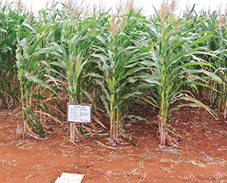WEMA Achi eves Major Milestone in African Agriculture
The WEMA project has developed conventional drought-resistant maize hybrids, which are sold under the brand name DroughtTEGO, as well as genetically modified (GM) varieties
By Winnie Nanteza
 The Water Efficient Maize for Africa (WEMA) project has concluded its first decade of research, achieving significant advances that are benefitting small-holder maize farmers in sub-Saharan nations.
The Water Efficient Maize for Africa (WEMA) project has concluded its first decade of research, achieving significant advances that are benefitting small-holder maize farmers in sub-Saharan nations.
Some 300 million Africans depend on maize as their main food source, but the crop is frequently destroyed by drought and insect pests, leading to hunger, poverty and human suffering. Hybrids developed under the WEMA project can help farmers better respond to droughts, and the associated loss in productivity, caused by climate change.
“It’s been a thrilling journey and a lot has been accomplished,” said Lawrence Kent of the Bill & Melinda Gates Foundation, which was joined by USAID and the Howard G. Buffett Foundation in funding WEMA. The public-private partnership is led by the nonprofit African Agricultural Technology Foundation (AATF). Other partners are the International Maize and Wheat Improvement Center (CIMMYT), Monsanto and the National Agricultural Research Systems (NARS) from the participating nations: Kenya, Uganda, Tanzania, South Africa, Ethiopia and Mozambique.
The WEMA project has developed conventional drought-resistant maize hybrids, which are sold under the brand name DroughtTEGO, as well as genetically modified (GM) varieties — to be marketed under the brand name TELA — that offer both drought tolerance and insect resistance. “When the project started 10 years ago, it was rather unclear how it would go,” said Mark Edge, director of WEMA partnerships at Monsanto, which offered to share its drought-tolerant and insect-resistant traits royalty-free for humanitarian purposes. “But together, we are making progress.” The various stakeholders met recently in Nairobi, Kenya, to discuss the achievements to date and plan for the next phase: deregulating and deploying the drought-tolerant and insect-resistant TELA maize hybrids for smallholder farmers in sub-Saharan Africa.
Tracy Powell, the USAID representative at the meeting, emphasized that WEMA has demonstrated the power and functioning of public-private partnerships.
Sylvester Oikeh, WEMA global project coordinator, said the next phase will focus on ensuring that Kenya, Uganda, Tanzania, Ethiopia and Mozambique initiate commercialization of the improved GM maize by 2023. South Africa commercialized insect-resistant (Bt) TELA maize and its farmers are currently growing the royalty-free seeds. The other countries are held back by the lack of legislation or policies to authorize the adoption of biotechnology.
Still, they have been moving forward with the field trials that are required for commercialization. In late 2017, Ugandan researchers reported promising results from its last set of confined field trials, conducted on WEMA maize with the two traits. However, Uganda must pass a biosafety bill before the seeds can be sold to farmers.
Mozambique harvested its first trial of the drought-tolerant, insect-resistant maize earlier this year. Researchers in both Mozambique and Uganda found that TELA maize, which was developed to deter attacks by the corn-borer pests, appeared to also successfully resist infestations by the destructive fall armyworm. Fall armyworm — first detected in West Africa in 2016 — has spread across the continent, devastating the maize fields that provide both food and income for smallholder farmers.
WEMA products also showed strong protection against maize lethal necrosis (MLN), according to Dr. Godfrey Asea, the project coordinator for Uganda. Meanwhile, Tanzania is conducting its second set of confined field trials on the drought-tolerant and insect-resistant variety, and Ethiopia planted its first GM TELA test crop this month.
Though Uganda has not yet approved the TELA maize, it has released about 10 conventionally-bred DroughtTEGO hybrids. This maize has the potential to give farmers an average yield of three tons per hectare in moderate drought conditions, and eight tons in well-watered conditions with good crop management, according to the AATF. WEMA is developing TELA hybrids that are also resistant to several foliar diseases, such as maize lethal necrosis, turcicum leaf blight and gray leaf spot, which can cause significant economic losses.
Though the WEMA project initially was projected to commercialize only 25 conventional hybrids, “up to 106 varieties have been released across the participating countries,” according Dr. Ambrose Agona, chairman of WEMA’s executive advisory board and director general of Uganda’s National Agricultural Research Organization. USAID’s Powell noted that these achievements with conventional maize are worth celebrating. “We have actually helped smallholder farmers improve their livelihoods,” she said. “We hope that the next phase of the project can make the necessary contribution to deliver even more compelling products to the farmers.”